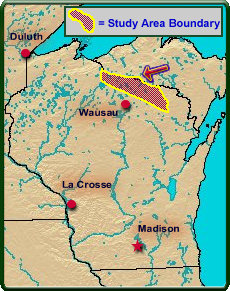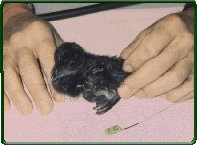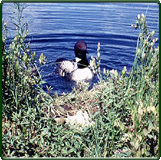Method Development for Determining Causes, Timing, and Magnitude of Mortality of Common Loon Chicks in Northern Wisconsin
 Recent
research in northern Wisconsin found that common loon (Gavia immer) productivity
was lower on lakes where chicks had elevated blood mercury levels. However,
these results are confounded with other ecological variables. Biologists
need a knowledge of mortality factors to discern the effects of mercury
exposure, prey abundance, and predator relationships on loon productivity.
Recent
research in northern Wisconsin found that common loon (Gavia immer) productivity
was lower on lakes where chicks had elevated blood mercury levels. However,
these results are confounded with other ecological variables. Biologists
need a knowledge of mortality factors to discern the effects of mercury
exposure, prey abundance, and predator relationships on loon productivity.
Traditional observation studies have provided limited information on loon chick productivity and have been ineffective in identifying the specific causes and timing of mortality.
Recent advances in implant techniques and transmitter miniaturization now provide a promising alternative.
 We
developed and evaluated a radio attachment technique for loon chicks and
followed the fates of individual chicks during the summers of 1997 and
1998.
We
developed and evaluated a radio attachment technique for loon chicks and
followed the fates of individual chicks during the summers of 1997 and
1998.
To accomplish this, we developed methods to collect loon eggs, to hold adults on nests while eggs were artificially incubated, to incubate and hatch eggs, implant radio transmitters, and release chicks back to nest.

Information on behavior, growth and development, energy expenditure, and survival were collected for both radio-marked chicks and nest mates that did not have transmitters. The marking technique proved successful and we identified several sources of loon chick mortality.
Contributing causes of mortality included attack by intruding adult loons, bald eagles, aquatic predators (e.g., large fish), and disease. This project provides new methodology that may be used to fill a critical information need in our understanding of common loon chick mortality and may have application to a host of bird species.
This project will be completed by October 2001.
Prinicpal Investigator: Kevin Kenow
Page Last Modified: April 3, 2018

